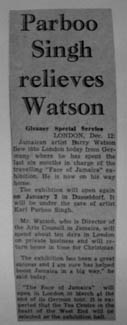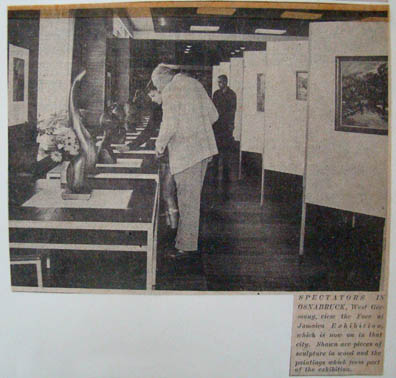Jamaica

The press on the island, it seems, was well aware that Face of Jamaica was an opportunity to stimulate international interest in the young nation. Certainly, the importance of the show as a glamorous showcase cannot be overestimated. The Daily Gleaner, Jamaica's national newspaper, tracked the show from start to finish reporting the opening receptions, attendance figures and giving updates on Barrington Watson, the leading artist and then Director of the Jamaica School of Art, and the painter Karl Parboosingh who stayed with the show for its duration.
The Jamaican reports unmistakably mirror the high expectations the government had for possible economic revenues as a result of the show’s success. Even though Face of Jamaica received extensive coverage, there was very little critical discussion of the works’ artistic qualities. The Daily Gleaner, for example, expressed:
This will be the first occasion on which Jamaica will be on view to the German people, who are among the most travelled in the world. The government considers this Exhibition to be one of great importance, bearing in mind our connection with Germany in so far as technical assistance, investment opportunities and trade are concerned.The Daily Gleaner’s editorial from 6 August 1963 even declared Face of Jamaica to be ‘the most important exhibition of Jamaican cultural development ever to be shown in Europe.’

The Daily Gleaner continuously updated its readers about the success of the exhibition: “More than 5,000 persons including many visitors from other West European countries saw the exhibition at Flensburg,” “average daily attendance of more than 100 people in Osnabrück,” “8,000 visitors of ‘Face of Jamaica’ show in Flensburg, Osnabrueck [sic], Freiburg, Munich,” “more than 10,000 persons have so far seen this exhibition.”
The photograph of Barrington Watson and the Jamaican Miss World, Carol Joan Crawford, viewing a sculpture by the self-taught artist Kapo tells us much about that post-independence moment and how Jamaica was poised to present itself to the outside world.
The juxtaposition is telling, Watson, trained academically in Europe, would go on to become one of the founders of an artist group that pushed modernist artistic principles and an internationalist outlook in Jamaica. In contrast, Kapo, along with other self-taught artists, was already being celebrated as an icon of an indigenous Jamaican art tradition, the roots of which were said to be inspired by Africa. Carol Joan Crawford as a world icon sent a message at home and abroad that Jamaica had style.

This encounter illustrates tensions that would become even more apparent in the coming decade; that being, the need to identify a ‘truly Jamaican’ artistic tradition and the aspiration of a young generation of artists to partake in the international art world. Indeed, a main concern of post-independence Jamaica was how to coalesce the urge for nationalism with a growing desire for modernity. This dichotomy is reflected in the multiple art styles showcased in About Face. ‘Being modern’ was generally associated with developments elsewhere, mainly in Europe and North America – in fact, there had been vigorous debates back home about whether the Caribbean was at all capable of generating modernity. These discussions amongst politicians and cultural agents impacted local cultural politics, but they also affected the face that Jamaica wanted to show to the outside world.

* Reproduction, including downloading of works is prohibited by copyright laws and international conventions without the express written permission of the artists.